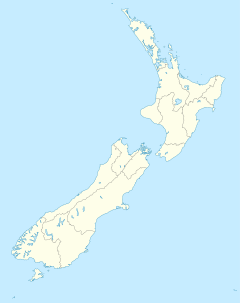Abel Tasman National Park
| Abel Tasman National Park | ||
|---|---|---|
| Frenchman Bay | ||
|
|
||
| Location: | Tasman , New Zealand | |
| Specialty: | New Zealand's smallest national park site of the first landing of a European in NZ |
|
| Surface: | 225.3 km² | |
| Founding: | 1942 | |
| Address: | Golden Bay Area Office 62 Commercial Street PO Box 166 Takaka Tel. 64 3 525 8026 |
|
The Abel Tasman National Park protects an area of 225.3 km² on the north coast of New Zealand's South Island . It is located at the northern end of a range of hills between the two large sea bays Golden Bay and Tasman Bay , about 70 km from Nelson . The altitude ranges from sea level to around 1150 m .
The park can be reached from Nelson via Motueka on the SH 60 .
Flora and fauna
The national park is famous for its numerous small bays with sandy beaches and turquoise water and its granite cliffs. At the same time, more than three quarters of the national park area are forested. The wildlife of the park is mainly shaped by its sea birds. For example, white-cheeked herons , stilts , Tara tern , Tui , korimakos , cuckoo owls and little penguins are native. Over 70 species of birds can be found in the national park.
climate
The climate in the coastal region is mild with 2200 hours of sunshine per year. At higher altitudes, greater amounts of precipitation fall and temperatures are lower. The annual mean temperature is 12.5 ° C, the annual precipitation is about 1380 mm.
history
In the Abel Tasman National Park is more present than in other New Zealand parks in addition to nature through the history of human settlement. The first Māori settled along this stretch of coast at least 500 years ago . In 1642 the Dutch navigator Abel Tasman was the first European to reach New Zealand and anchor here. From around 1855 the region began to be colonized by white immigrants who felled wood and tried to gain arable land by clearing and burning . It was also in places in quarries granite mined. The need to protect the unique landscape from further exploitation was recognized early in the 20th century. Today, as the area is under nature protection, relatively little can be seen of the human interference. A geological feature of the park are its karsts and caves (in the area of Takaka Hill and Canaan Downs).
New Zealand's smallest national park was established in 1942, 300 years after Abel Tasman's landing, and named after the discoverer. The 51 km long Abel Tasman Coastal Track is particularly popular among visitors to the park . Another popular way to explore Abel Tasman National Park is by kayaking along the coast. The starting points for most tours are the towns of Marahau and Totaranui , the southern and northern ends of the coastal hiking trail. In 2004, 184,000 visitors visited the park, making it one of the most visited national parks in New Zealand.
The sea off the coast of the Abel Tasman National Park has been strictly protected since 1993 by the immediately adjacent 18.35 km² Tonga Island Marine Reserve .
Picture gallery
Individual evidence
- ↑ a b W. Hood: Abel Tasman National Park (PDF; 81 kB), 2010
- ^ PA Williams: Hakea salicifolia: Biology and role in succession in Abel Tasman National Park, New Zealand , Journal of the Royal Society of New Zealand, 22: 1, 1-18, 1992, doi : 10.1080 / 03036758.1992.10420814
Web links
- Department of Conservation: Abel Tasman Coast Track (English)
- natureandco.co.nz (English)
- Pictures from the Abel Tasman National Park (German, English)
- Skylark Productions Photos from Abel Tasman National Park
- Interactive Panorama from Kayaking in Abel Tasman National Park (1)
- Interactive panorama from Abel Tasman National Park (2)








